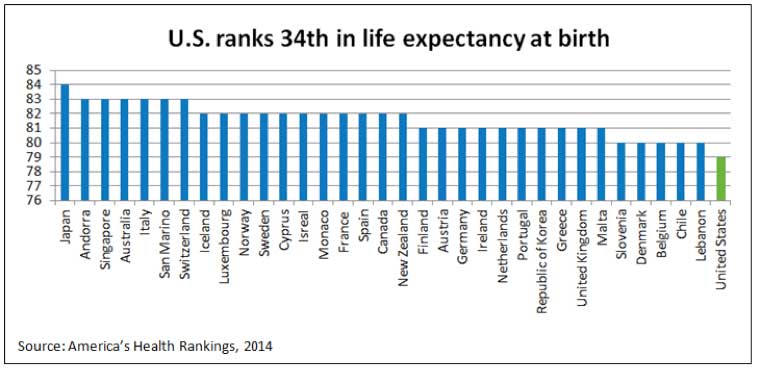Health Rankings
Healthiest Communities Rankings aim to help drive meaningful change
From Public Health Newswire: What can we learn from the nation's healthiest communities?
Many people find it hard to believe the U.S. performs poorly on most measures of health compared to other high-income countries. But the truth is, study after study supports the same two conclusions:
- The U.S. spends more on health care but has worse health outcomes than comparable countries around the globe. This holds true across age and income groups.
- Within the U.S., there are unacceptable disparities in health by race and ethnic group, county by county and state by state.
High spending and poor health compared to other countries
Whether you measure health spending on a per capita basis or as a percentage of gross domestic product, the U.S. spends more than two times the average of comparable countries.
A 2014 Commonwealth Fund report, for the fifth time in 10 years, ranked the U.S. dead last against comparable countries. That was in measures such as quality of care, access to care, equity and healthy lives.
A 2011 National Research Council study found the U.S. trailed other high-income countries in life expectancy and other measures of good health. More analysis by the NRC and the Institute of Medicine in 2013 found it's not just low-income and minority groups driving the trend. It's true across all ages and incomes. In the U.S., even if you are white, high income, well-educated and have good insurance, you appear to be in worse health than your peers in other developed countries.

The Institute of Medicine looked deeply into U.S. health performance vs. 16 of the most fairly comparable, high-income countries. Their study found that people in the United States have:
- Shorter lives — over the past 25 years, U.S. life expectancy has grown, but at a lower rate than in other countries.
- Bad birth outcomes — we have the highest rates of infant mortality, low birth weight, women dying due to complications of pregnancy and childbirth and children less likely to live to age 5.
- More injuries and homicides — deaths from motor vehicle crashes, non-transportation injuries and violence happen at much higher rates.
- Heart disease — the U.S. death rate from ischemic heart disease is the second highest. Adults over age 50 are more likely to develop and die from cardiovascular disease.
- Obesity and diabetes — for decades, the U.S. has had the highest obesity rate across all age groups, and American adults have high rates of diabetes.
- Chronic lung disease — lung disease is more common and associated with higher risk for death.
- Disability — Older U.S. adults report a higher prevalence of arthritis and limits to their daily activities.
- Adolescent pregnancy and sexually transmitted disease — our youth have the highest rate of pregnancy and are more likely to acquire sexually transmitted diseases.
- HIV and AIDS — we have the second highest prevalence of HIV infection and the highest incidence of AIDS.
- Drug-related death — we lose more years of life to alcohol and other drugs even when deaths from drunk driving are excluded. In fact, the president's 2014 National Drug Control Strategy noted overdose deaths now surpass homicides and car crash deaths.
While this sounds dire, the good news is that the public health community is already implementing programs to address these challenges. We need to ensure funding is available to bring proven programs to every community. And we can’t do it alone. We need your support for strong funding levels and your help expanding our partnerships to all sectors impacting health – from city planners and education leaders, to public officials, private and for-profit groups.
From The Nation's Health: What makes communities healthy? New rankings showcase successes

